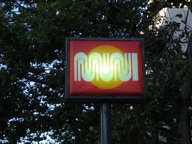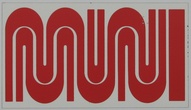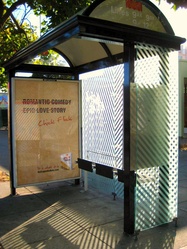 The Muni logo, which is fairly kick ass.
The Muni logo, which is fairly kick ass.  Logo from a bus
Logo from a bus
 A bus stop (2008) with Anti sleeping seats. Muni is the San Francisco Municipal Railway, a public transportation system for San Francisco. It is comprised of buses, several rail lines, trolley buses, and cable cars. Some Muni stations are also BART stations.
A bus stop (2008) with Anti sleeping seats. Muni is the San Francisco Municipal Railway, a public transportation system for San Francisco. It is comprised of buses, several rail lines, trolley buses, and cable cars. Some Muni stations are also BART stations.
Transfers typically last 90 minutes from the time of payment, but starting at around 8:30 they're good for the rest of the night. Passengers carrying a Fast Pass may travel on any Muni bus, train, trolley or cable car at no additional cost.
Throughout the Muni system, buses are numbered while trains are known by letters of the alphabet — except for the letter X, which represents an express bus line.  The Muni Metro J heading through Noe Valley. (2007)
The Muni Metro J heading through Noe Valley. (2007)
The Muni rail lines (known as Muni Metro) are as follows:
The rail lines go both above and below ground.
-
F Market & Wharves — Historic and restored trolley cars serve this line. Runs above ground from the Castro down Market Street along the Embarcadero to Fisherman's Wharf.
-
There used to be an E Embarcadero line, also running historic streetcars, from 4th and King to Fisherman's Wharf. This service has since ended, but you can still see occasional signs for it along platforms, and it might come back someday. The area it served is covered now by the F line and the N / T lines.
Double-decker buses
Muni conducted a test run of double-decker buses from December 12, 2007 to January 8, 2008 on the 1BX, 14L, 38, 38L, and 49 lines. Fares on these trial buses were waived, but riders were asked to complete a survey about their experience.
Hybrid buses
On April 11, 2007, the first diesel hybrid electric buses appeared on the streets of San Francisco in an effort to reduce overall Muni emissions by 30% by the year 2012. The city also plans on its fleet becoming 100% free of greenhouse gas emissions by the year 2020. The city bought 86 of these buses from Daimler-Chrysler and planned to have the third-largest hybrid bus fleet in the United States by the end of July 2007. These buses are different from the Toyota Prius hybrid car — Muni's buses use series hybrid systems, while the Prius runs on parallel hybrid technology. You can read more about series versus parallel hybrid systems here. More information about Muni's transition to hybrid buses can be found here.
Projects
Central Subway Project
The city hopes to install a new underground rail running from the Caltrain terminal at Fourth and King streets, extending west along Fourth, stretching north along Stockton Street and coming to an end at Clay Street. This will add four new stations:
- Fourth and Brannan streets
- Fourth Street, between Howard and Folsom streets
- Stockton Street near Market Street
- Stockton Street and Clay Street
Geary Corridor Bus Rapid Transit Study
The San Francisco County Transit Authority is working on a plan to increase bus reliability along Geary Boulevard, the busiest street in the northern part of the city. The plans began with the 2003 passage of Proposition K to build BRTs in San Francisco. With a planned phase 1 start date of the year 2011, the SFCTA has been studying the feasibility of adding a bus-only lane along the middle of Geary since 2004. Though there aren't any current plans to include a light rail on Geary (due to a lack of funds), the BRT lane will most likely be built with the possibility of a future light rail in mind. Read more about the city's plans for the Geary BRT plan here. The Greater Geary Boulevard Merchants and Property Owners Association has an anti-Geary BRT site.
Van Ness Avenue Bus Rapid Transit
Like with the Geary BRT study, the city is looking into installing a two-mile-long, bus-only lane along the busy thoroughfare Van Ness Avenue as a result of Proposition K. Construction may begin as early as 2009, with service introduced as early as 2010 — if the project is found feasible; the SFCTA has been coordinating the study with Caltrans to research whether the plan will work. More info on the Van Ness BRT study can be found here.
Muni of Tomorrow
 Packard Jennings and Steve Lambert (public domain)
Packard Jennings and Steve Lambert (public domain)
In November of 2007 the city's Art on Market Street program featured illustrations by Packard Jennings and Steve Lambert that were inspired by the question "what would you do if you didn’t have to worry about budgets, bureaucracy, politics, or physics?"
More information
 Some covered bus stops now have NextMuni marquees.
Some covered bus stops now have NextMuni marquees.
- Official Muni site — has schedules, routes, fares, and other information
- NextMuni.com can tell you when your Muni bus is coming, on essentially every route. Some Muni bus stops have scrolling LED panels that will tell you with the next bus is coming, and a few of them have button-operated recordings of this information. The "NextBus" system works using GPS units mounted on the buses and communicates with the panels using the local cell network (more info on how it works).
It is kind of wasteful for the non-moving devices to also use wireless to get the information, just one more reason why there should be a municipal wired (fiber?) data network. Stop unnecessary radio pollution! —NickSchmalenberger
Dude, it's like, tens of bytes worth of traffic, versus digging up the street to install fiber. And wireless is much more resilient to the errant backhoe. Wireless for eva.
-
http://www.sfmunicentral.com gives a bigger picture of what's going on the subway, albeit more confusing.
The abbreviations are the first two letters of each station, from left to right:
- WE = West Portal station
- FH = Forest Hill station
- CA = Castro station
- CH = Church station
- VN = Van Ness station
- CC = Civic Center station
- PO = Powell station
- MO = Montgomery station
-
EM = Embarcadero station
(L = outbound, R = inbound)
- http://www.511.org can help you plan your itinerary to and from anywhere in the Bay Area.
- http://www.hopstop.com has itinerary information as well.
- The "Directions" page has additional information that can help you get to where you need to go.
- Rescue Muni is an organization formed by citizens that is aimed at improving safety and reliability on Muni.
- Muni Diaries. Rider tales about San Francisco's sometimes crappy, but essential transportation system.


